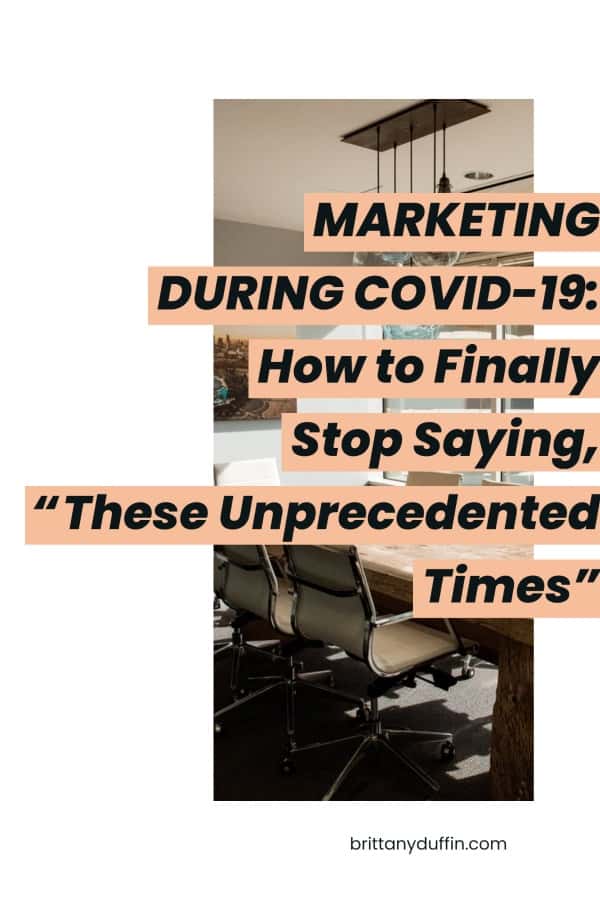Raise your hand if you are sick and tired of hearing businesses claim that they are “here for you during these unprecedented times.” 🙋🙋🙋🙋🙋
Guys, stop doing this. Please. STOP DOING THIS.
This is making you look unprepared (which I wouldn’t blame anyone for, but let’s try to keep our composure here), self-serving, insincere and desperate.
You heard me.
Desperate.
Also, it’s been almost 5 months since quarantine restrictions first started.
We get it.
Things have been weird.
But we need to stop using this phrase in our marketing communications.
Right now.
Now I know what you’re wondering: “But what if we really are here for them and we can help them out during these times??”
Quit referring to the present tense as “these times!”
We as marketers need to accept that we are in a new normal, and even if business operations and social distancing recommendations have changed more swiftly and are lingering longer than we would have preferred, that is a reality of doing business.
Your audience isn’t necessarily thinking in terms of “these times” versus “those times.”
If you can help your customers in a new way, or even help a new customer segment, then just tell them how you can help them.
Simple as that. Don’t over-complicate things.
You don’t have to literally say you’re here to help.
ESPECIALLY not “now more than ever,” God. 🙄

A call for less jargon
If you subscribe to copywriting guru Ann Handley’s email newsletter, Total Annarchy (and if you don’t, you should), you might have seen her Aug 2nd weekly tip on buzzwords:
Jargon is like cholesterol: There’s a good kind and there’s a bad kind. The good kind is a shorthand used in many industries that signals you speak the language of your customers. The bad kind is often used when the speaker isn’t creative or smart enough to find better words.
At first, I thought this was the problem:
Marketers are trying to connect with their customers and signal that they are in tune with customers’ needs “during these times,” but in reality they are not creative or smart enough to find the right words.
So I started writing this post with the intention of sharing alternative words and phrases to use instead of the dreaded “unprecedented times.”
(And if that’s still what you’re looking for, Marketing Profs has a great overview.)
But the more I thought about it, the more I came to realize that the problem is not the words themselves, or the combinations of phrases, “unprecedented times,” “now more than ever,” “for the safety and well-being of our customers and staff,” or “we’re here to help” — however uncreative they may be.
(Seriously, how many times have you heard them?)
The problem, I suspect, is that they’re being said when there is literally nothing else of substance to say.
And that is a bigger, scarier problem.
What does this mean for marketers?
I get it.
So many businesses, especially the smaller ones or those dependent on in-person services and contact, are struggling to pivot their business models and communicate these changes both internally and externally.
That’s a tough place to be.
I don’t blame marketers for scrambling to connect, stay relevant, and rise above the noise.
We’re all wondering the same things:
Is now a good time to launch a promotion or new product?
Are we being insensitive?
Should we call out the elephant in the room or risk sounding tone-deaf?
How can we keep generating revenue and sales leads?
But a harsh reality facing marketers is that you can’t make something out of nothing.
If your organization as a whole hasn’t actually done anything to better serve your customers as their needs and other external factors continue to change, then what can you say?
As my freshman year AP English teacher Mr. Orlopp would say, “You can’t polish a turd.”
There is simply no alternative for clear, honest and genuine messaging that is true to your brand.
At the end of the day, your marketing communications all come back to (you guessed it) the customer.
Regardless of “the times” we’re living in, the only thing that matters is what they want, what they need, and how you can actually help them.
A guide to marketing during COVID
So before you start typing the U-word, here are some considerations for my fellow marketers and copywriters:
1. Decide whether or not to say anything at all
Before hitting publish on any marketing communications, take a step back as news stories quickly develop.
It’s easy to jump into panic mode and feel like you have to respond to anything happening in the market or on the news, but if you’re going to say anything, make it valuable.
You don’t have to say what everyone else is saying.
It’s possible no one is looking for a response from your brand at all.
(Ouch, I know.)
2. Ask yourself why anyone should care
One of the fastest ways to develop your campaign messaging is to simply ask yourself why anyone should care.
This is an excellent and effective copywriting exercise, COVID or not:
Let’s say you are trying to communicate a new, contact-free ordering and pickup process.
Take a look at your original marketing messaging, and ask yourself, “so what?”
So… if people are social distancing, they might care about this new process because they don’t have to interact with anyone.
So what?
So… they can continue to shop without the risk of spreading COVID.
So what?
So… we are finding new ways to help our customers find a sense of normalcy and continue their daily activities while maintaining a level of safety.
There we go!
That’s way better than, “We’re here to help during this unprecedented times,” right?
Just keep asking yourself, “so what?” until you have a very clear reason why your audience should care.
Does your statement add tangible value to your customers?
Can you save them time or money, or help them achieve their goals?
Is it helpful, useful, entertaining or inspiring?
Revisit your value proposition statement to guide this process.
3. Consider what has actually changed
What may feel like a seismic shift to your business may not seem that unusual to your customers.
They’re likely already painfully aware of any new guidelines, restrictions, and safety concerns, and they’re already expecting your business to be aware and in compliance.
So just get to the point from step 2.
Consider how you would have framed this campaign pre-COVID, and ask yourself if it’s still relevant.
What has actually changed, and how can you adjust for that change without just slapping on an insincere intro statement?
Revisit your customer personas and think about what exactly has changed for these people (media consumption, work environment, spending habits, social habits, stresses and fears) and what that means for your brand/product.
If you can segment your audience to send the right message to the right people, do that.
4. Be empathetic
Always, always, always.
A good copywriting exercise that helps me to be more empathetic is to imagine the customer as they are interacting with the campaign.
Seriously, imagine someone scrolling past your display ad or social media post.
Actually visualize a human checking their inbox and seeing your promo email.
Where are they? Outside? At a desk? On their phone?
Is there a screaming child in the background?
Have they just been laid off?
What does that person hope to see from your brand?
How can you actually help that person?
Connection requires empathy.
5. Be proactive about how your brand will respond in the future
Fingers crossed we don’t have another global pandemic, but there will always be gloomy doomy news headlines and industry disruptions.
When this happens, it is likely that it will affect your revenue and sales, and that your senior leadership team will suggest that we “send out an email campaign” thinking that will fix everything.
As a marketer, it is your job to advocate for your customer and campaign internally for an alternative approach that feels more authentic and true to your brand.
Revisit these recommendations during the creative briefing process of every campaign, regardless of world news.
Continuously evaluate what’s going on in your target audience’s heads and what that means for your product, brand and messaging.
It will result in better client retention and stronger brand loyalty.
I promise.
Conclusion
At the end of the day, the customer should guide all marketing messaging — what they want, and what they need.
If you can ditch the jargon and develop messaging that speaks to those wants and needs, your marketing messaging will be much more genuine, and therefore much more effective.
Now, I want to hear from you:
Have you seen any unique and appropriate marketing during COVID that successfully avoided the “unprecedented times” messaging?
What’s your favorite eye-roll-inducing campaign?
Let me know in the comments!

My name is Brittany, and I have 10 years of experience in copywriting and digital and direct-response marketing.
I’m here to help you sharpen your writing skills and enhance your marketing messaging. When I’m not brainstorming the next best subject line, you can find me watching scary movies, skating, and taking pictures of my food.